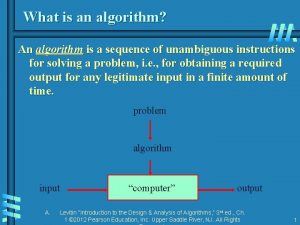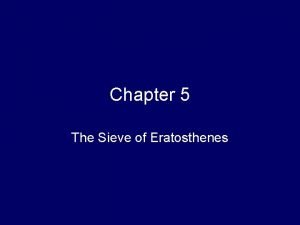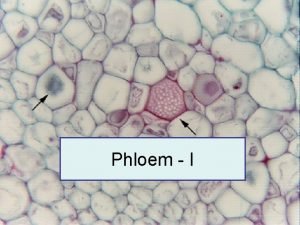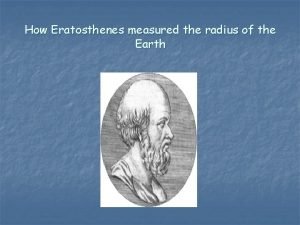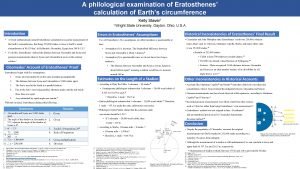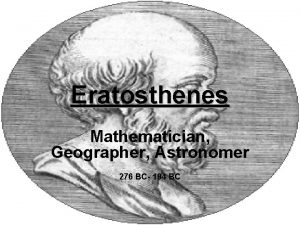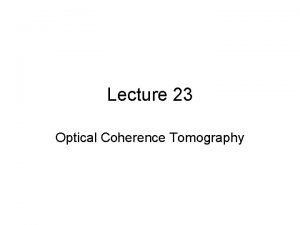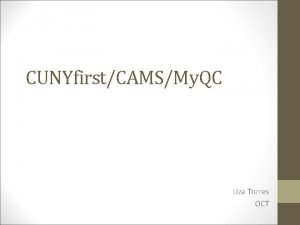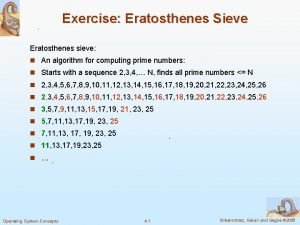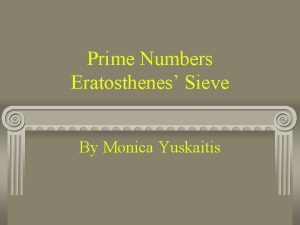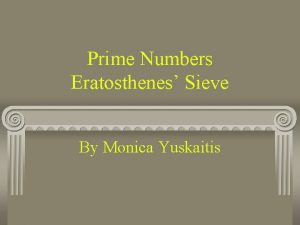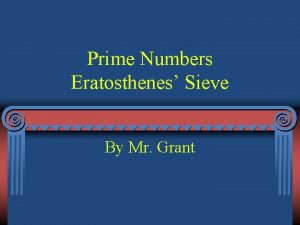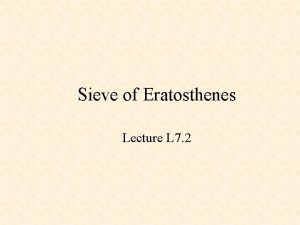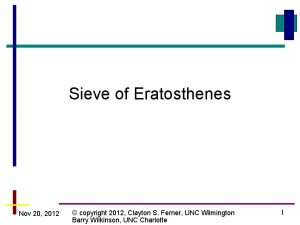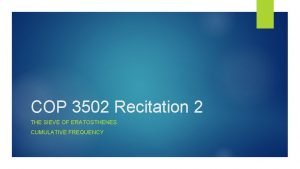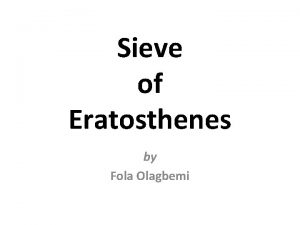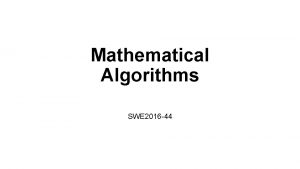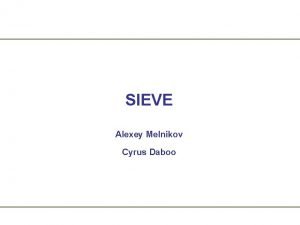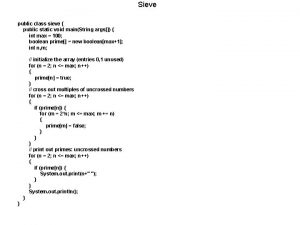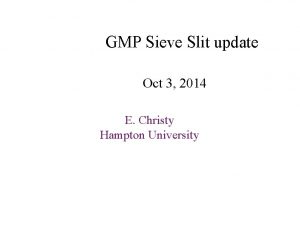Sieve of Eratosthenes Oct 24 2013 copyright 2013





![Sequential Sieve of Eratosthenes Algorithm (pseudo-code) Sieve_Eratosthenes(int n) { boolean marked [n] = { Sequential Sieve of Eratosthenes Algorithm (pseudo-code) Sieve_Eratosthenes(int n) { boolean marked [n] = {](https://slidetodoc.com/presentation_image_h2/476c9a1029ce3340a4f0a2100c25a07f/image-6.jpg)

















- Slides: 23

Sieve of Eratosthenes Oct 24, 2013 © copyright 2013, Clayton S. Ferner, UNC Wilmington Barry Wilkinson, UNC Charlotte 1

Sieve of Eratosthenes • The Sieve of Eratosthenes is an algorithm to find the prime numbers between 2 and n • Start with an array of booleans from 2 to n initially set to all true • For each known prime starting with 2, mark all the multiples (composites) of that prime • Stop when the next prime > √n • What is left unmark are the primes Oct 24, 2013 © copyright 2013, Clayton S. Ferner, UNC Wilmington Barry Wilkinson, UNC Charlotte 2

Sieve of Eratosthenes 2 3 4 5 6 7 8 9 10 11 12 13 14 15 16 17 18 19 20 21 22 23 24 25 26 27 28 29 30 31 32 33 34 35 36 37 38 39 40 41 42 43 44 45 46 47 48 49 50 51 52 53 54 55 56 57 58 59 60 61 62 63 64 Next Prime = 2 2 3 4 5 6 7 8 9 10 11 12 13 14 15 16 17 18 19 20 21 22 23 24 25 26 27 28 29 30 31 32 33 34 35 36 37 38 39 40 41 42 43 44 45 46 47 48 49 50 51 52 53 54 55 56 57 58 59 60 61 62 63 64 Oct 24, 2013 © copyright 2013, Clayton S. Ferner, UNC Wilmington Barry Wilkinson, UNC Charlotte 3

Sieve of Eratosthenes Next Prime = 3 2 3 4 5 6 7 8 9 10 11 12 13 14 15 16 17 18 19 20 21 22 23 24 25 26 27 28 29 30 31 32 33 34 35 36 37 38 39 40 41 42 43 44 45 46 47 48 49 50 51 52 53 54 55 56 57 58 59 60 61 62 63 64 Next Prime = 5 2 3 4 5 6 7 8 9 10 11 12 13 14 15 16 17 18 19 20 21 22 23 24 25 26 27 28 29 30 31 32 33 34 35 36 37 38 39 40 41 42 43 44 45 46 47 48 49 50 51 52 53 54 55 56 57 58 59 60 61 62 63 64 Oct 24, 2013 © copyright 2013, Clayton S. Ferner, UNC Wilmington Barry Wilkinson, UNC Charlotte 4

Sieve of Eratosthenes Next Prime = 7 2 3 4 5 6 7 8 9 10 11 12 13 14 15 16 17 18 19 20 21 22 23 24 25 26 27 28 29 30 31 32 33 34 35 36 37 38 39 40 41 42 43 44 45 46 47 48 49 50 51 52 53 54 55 56 57 58 59 60 61 62 63 64 Next Prime = 11 112=121 > 65 so stop Oct 24, 2013 © copyright 2013, Clayton S. Ferner, UNC Wilmington Barry Wilkinson, UNC Charlotte 5
![Sequential Sieve of Eratosthenes Algorithm pseudocode SieveEratosthenesint n boolean marked n Sequential Sieve of Eratosthenes Algorithm (pseudo-code) Sieve_Eratosthenes(int n) { boolean marked [n] = {](https://slidetodoc.com/presentation_image_h2/476c9a1029ce3340a4f0a2100c25a07f/image-6.jpg)
Sequential Sieve of Eratosthenes Algorithm (pseudo-code) Sieve_Eratosthenes(int n) { boolean marked [n] = { true, . . . }; prime = 2; while (prime * prime < n) { // or prime < sqrt(n) composite = prime * prime; // start with prime^2 while (composite < n) { marked[composite] = false; composite = composite + prime; // multiples of prime } do { prime++; } while (marked[prime]); // find next prime } Oct 24, 2013 © copyright 2013, Clayton S. Ferner, UNC Wilmington Barry Wilkinson, UNC Charlotte 6

Sequential Complexity • The outermost loop will iterate at most √n times • The 1 st inner loop could iterate up to n/2 times • The 2 nd loop will iterate √n times total (for all iterations of the outermost loop) • Complexity = Oct 24, 2013 © copyright 2013, Clayton S. Ferner, UNC Wilmington Barry Wilkinson, UNC Charlotte 7

Parallelizing Sieve of Eratosthenes • An obvious approach is to parallelize the loop marking multiples of prime composite = prime * prime; while (composite < n) { marked[composite] = false; composite = composite + prime; } • We can rewrite this as a for loop: for (composite=prime*prime; composite < n; composite += prime) { marked[composite] = false; Oct 24, 2013 © copyright 2013, Clayton S. Ferner, UNC Wilmington Barry Wilkinson, UNC Charlotte 8

Parallelizing Sieve of Eratosthenes • Now we have a Scatter/Gather pattern • We only need to broadcast n • We don’t really need to broadcast the initial array “marked” because all processors can initialize it • The difficulty is in selecting the next prime • We have to do a reduction and broadcast of the marked array so all processors can continue updating the array Oct 24, 2013 © copyright 2013, Clayton S. Ferner, UNC Wilmington Barry Wilkinson, UNC Charlotte 9

Parallelizing Sieve of Eratosthenes Sieve_Eratosthenes(int n) { boolean *marked; #prgama paraguin begin_parallel #pragma paraguin bcast n // Allocate an array of n ints marked = malloc (n * sizeof(int)); for (int i = 0; i < n; i++) marked[i] = 1; // True prime = 2; while (prime * prime < n) { Oct 24, 2013 © copyright 2013, Clayton S. Ferner, UNC Wilmington Barry Wilkinson, UNC Charlotte 10

Parallelizing Sieve of Eratosthenes composite=prime*prime; We need the loop num. Iterations = n / prime – prime; to be a simple loop #pragma paraguin forall for (i = 0; i < num. Interations; i++) { marked[composite] = false; composite += prime } #pragma paraguin reduce land marked temp // copy temp back into marked #pragma paraguin bcast marked( n ) do { prime++; } while (marked[prime]); Oct 24, 2013 © copyright 2013, Clayton S. Ferner, UNC Wilmington Barry Wilkinson, UNC Charlotte 11

Parallelizing Sieve of Eratosthenes • A better approach is to partition the array instead of the loop • With p processors, each processor is responsible for elements of the array • It is the master process’ responsibility to determine the next prime • This need to be broadcast, but we can eliminate the reduction • Also, only a single integer needs to be broadcast instead of an array Oct 24, 2013 © copyright 2013, Clayton S. Ferner, UNC Wilmington Barry Wilkinson, UNC Charlotte 12

Sieve of Eratosthenes √n primes will be used. These need to be within the master process’ region. 2 3 4 5 6 7 8 9 10 11 12 13 14 15 16 p 0 17 18 19 20 21 22 23 24 25 26 27 28 29 30 31 32 p 1 33 34 35 36 37 38 39 40 41 42 43 44 45 46 47 48 p 2 49 50 51 52 53 54 55 56 57 58 59 60 61 62 63 64 p 3 Oct 24, 2013 © copyright 2013, Clayton S. Ferner, UNC Wilmington Barry Wilkinson, UNC Charlotte 13

Parallelizing Sieve of Eratosthenes • First we need to make sure the master process will compute √n values • The master process needs to be able to determine all values used for prime #pragma paraguin begin_parallel proc 0_size = (n-1)/__guin_NP; if (2 + proc 0_size < (int) sqrt((double) n)) { if (__guin_rank == 0) printf (“Too many processorsn”); return 1; } Oct 24, 2013 © copyright 2013, Clayton S. Ferner, UNC Wilmington Barry Wilkinson, UNC Charlotte 14

Parallelizing Sieve of Eratosthenes low_value = (__guin_rank*n-1)/__guin_NP; high_value = ((rank+1)*n-1)/__guin_NP; prime = 2; do { Partition the array: each processor is responsible for values from low to high Compute the first multiple of prime greater to or equal to low_value if (low_value % prime == 0) first = low_value; else first = low_value + prime – (low_value%prime); Mark multiple of prime in each processor’s range for (i=first + prime; i < high_value; i += prime) marked[i] = false; Oct 24, 2013 © copyright 2013, Clayton S. Ferner, UNC Wilmington Barry Wilkinson, UNC Charlotte 15

Parallelizing Sieve of Eratosthenes if (__guin_rank == 0) { do { prime++; } while (marked[prime]); } Master determines next prime and broadcasts it. #pragma paraguin bcast prime } while (prime * prime < n); No reduction is needed until we finish the computation #pragma paraguin gather marked( n ) Oct 24, 2013 © copyright 2013, Clayton S. Ferner, UNC Wilmington Barry Wilkinson, UNC Charlotte 16

Parallel Complexity • The outermost loop will iterate √n times • The 1 st inner loop could iterate up to n/2 p times with p processors • The 2 nd loop will iterate √n times total (for all iterations of the outermost loop) • The broadcast take log(p) time • Complexity = Computation Oct 24, 2013 Communication © copyright 2013, Clayton S. Ferner, UNC Wilmington Barry Wilkinson, UNC Charlotte 17

Improving the Parallel Algorithm • Still we have a broadcast within the outermost loop • How can we eliminate that? • Can we have all processors determine what the next prime is? Oct 24, 2013 © copyright 2013, Clayton S. Ferner, UNC Wilmington Barry Wilkinson, UNC Charlotte 18

Improving the Parallel Algorithm • The number of primes used in the Sieve of Eratosthenes is √n • All processors compute the primes from 2 … √n • Now all processors have their own private copy of the primes used • We can eliminate the broadcast • As well as the requirement that the master process’ section be at least √n Oct 24, 2013 © copyright 2013, Clayton S. Ferner, UNC Wilmington Barry Wilkinson, UNC Charlotte 19

Complexity • The complexity is essentially the same for most processors, except: – Communication is eliminated until the end – There is added complexity to compute the first √n primes sequentially • Complexity to compute the first √n primes: Oct 24, 2013 © copyright 2013, Clayton S. Ferner, UNC Wilmington Barry Wilkinson, UNC Charlotte 20

Complexity • Final Complexity: • Implementation left as an exercise Oct 24, 2013 © copyright 2013, Clayton S. Ferner, UNC Wilmington Barry Wilkinson, UNC Charlotte 21

Questions Oct 24, 2013 © copyright 2013, Clayton S. Ferner, UNC Wilmington Barry Wilkinson, UNC Charlotte 22

Discussion Question • Question: Would it be better to implement this algorithm in shared-memory (using Open. MP) than distributed-memory (using MPI)? Oct 24, 2013 © copyright 2013, Clayton S. Ferner, UNC Wilmington Barry Wilkinson, UNC Charlotte 23
 Consecutive integer checking algorithm for gcd
Consecutive integer checking algorithm for gcd Sieve of eratosthenes parallel
Sieve of eratosthenes parallel Ordinary companion cells
Ordinary companion cells Erastothenes
Erastothenes Eratosthenes assumptions
Eratosthenes assumptions Aristarchus and eratosthenes
Aristarchus and eratosthenes Eratosthenes ap human geography
Eratosthenes ap human geography 194 bc
194 bc Eratosthenes solar system
Eratosthenes solar system Mbti personal impact report
Mbti personal impact report Jhlt. 2019 oct; 38(10): 1015-1066
Jhlt. 2019 oct; 38(10): 1015-1066 Ciclo alcino
Ciclo alcino Bi tri quad pent
Bi tri quad pent Classification of hydrocarbons
Classification of hydrocarbons Meth eth
Meth eth Hept oct non dec
Hept oct non dec Principle of oct
Principle of oct Butanoat de metil
Butanoat de metil Jhlt. 2019 oct; 38(10): 1015-1066
Jhlt. 2019 oct; 38(10): 1015-1066 Cuny first qc
Cuny first qc Scleral lens oct
Scleral lens oct About gandhi in english
About gandhi in english Saturated bond
Saturated bond Met et prop but pent hex hept oct non dec undec
Met et prop but pent hex hept oct non dec undec
